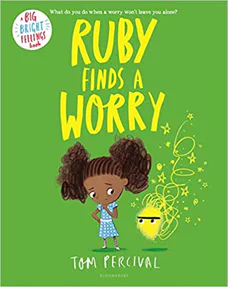Ruby Finds a Worry
Written and illustrated by Tom Percival
32 pages
•
Published 2019 (Bloomsbury Children’s Books)

Recommended Age Range: This book is short with simple language–preschoolers through 2nd grade.
Publisher's Summary:
Meet Ruby – a happy, curious, imaginative young girl. But one day, she finds something unexpected: a Worry. It’s not such a big Worry, at first. But every day, it grows a little bigger … and a little bigger … Until eventually, the Worry is ENORMOUS and is all she can think about. But when Ruby befriends a young boy, she discovers that everyone has worries, and not only that, there’s a great way to get rid of them too . . . she just has to share her feelings.

Dr. Annie's Takeaways
Recommended for: This book is great to read with children who seem to be carrying heavy feelings around with them and not sharing them. Kids with worries and/or mood symptoms would likely benefit from reading this book–the message that one can feel better by connecting with others and sharing one’s feelings is quite applicable to both depression symptoms as well as worries. For therapists, this book could be helpful as a read early in therapy with a child who isn’t sure talking about their feelings will help at all.
Would a child like it? Yes. It’s short, optimistic, compassionate, and not preachy at all. It takes seriously the worries that young children can feel and how much suffering this can cause. Young children’s worries are often invalidated by well-meaning adults who might find a child’s worries to be silly, and this book doesn’t take that approach at all.
Evidence-Based Practices:
Emotional Processing
Tone: Sweet, compassionate
Story Quality: This simple story is compelling and earnest, and it takes seriously the havoc that a Worry can wreak on a young child’s life. Many children (and adults) will relate to the visual metaphor of Ruby’s Worry as a growing blob with angry eyebrows. The resolution of the story is sweet–Ruby befriends another boy with his own Worry, and they share their Worries with each other, making both of their Worries go away.
Illustrations: As Ruby’s yellow blob of Worry grows and grows, the illustrations lose their color until the pages are just black and white, with a big yellow blob. As she talks about her worries, and her Worry shrinks, the color comes back to the pages. It’s a great, effective way to show how worries can drain the color out of one’s life, and how talking about one’s worries with another caring person can bring the color back!
Representation: Ruby is a Black girl with two parents who are shown in one small picture and appear to be a woman and a man. The other main character is a White boy. Ruby’s Worry is a non-specific yellow blob, which leaves space for kids to describe their own Worries using whatever language fits for them.
Psychological Practices: The primary psychological concepts represented here are that worries grow by worrying about them and by keeping them to oneself, and that worries shrink when you talk with someone about them. There are some kids with some worries for whom this message is spot on. For a child who seems to have something on their mind (i.e., the “dark cloud”), but they don’t want to talk about what is bothering them, this book could be a perfect entry point to a conversation. This book also leads well into an activity where children can draw pictures of their own Worries and talk about how their Worry is changing shape and size over time. For children who are reassurance seekers or who are already talking a lot about their worries, this book is less relevant. The message that worrying about a worry makes it bigger is still relevant to these kids, but a different solution would need to be discussed (e.g., how to notice the worry but not get sucked into it). I worry that it could be disheartening to a child if they have already talked with someone about their worries and they didn’t shrink as this book promises.
Concerns: There is mention at the end of the book that Ruby still gets a Worry “from time to time” but now she knows how to get rid of them (i.e., by telling someone about them). For many kids with significant worries (e.g., those with Generalized Anxiety Disorder), their worries never fully go away, but they can learn to live with them and not let the worries take over. I would have preferred an ending that didn’t suggest that the worries need to fully go away in order for Ruby to feel like herself and be happy.
